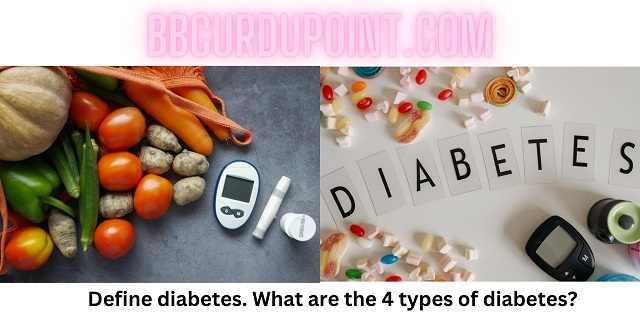Define diabetes. What are the 4 types of diabetes?
Diabetes is a chronic medical condition that occurs when the body is unable to properly regulate blood sugar (glucose) levels. This happens either because the body doesn’t produce enough insulin or because the cells in the body do not respond effectively to insulin. Insulin is a hormone produced by the pancreas that helps glucose from food enter cells to be used for energy.
The Four Types of Diabetes: Causes, Symptoms, Diagnosis, and Treatment
Diabetes is a chronic condition affecting millions globally, characterized by the body’s inability to properly regulate blood sugar (glucose) levels. There are four main types of diabetes, each with distinct causes, symptoms, and treatments. This comprehensive guide will provide detailed information on these types, their symptoms, causes, diagnostic methods, and the available treatment options.
1. Type 1 Diabetes: Causes, Symptoms, and Treatment
What is Type 1 Diabetes?
Type 1 diabetes is an autoimmune condition where the immune system mistakenly attacks and destroys insulin-producing beta cells in the pancreas. As a result, the body cannot produce insulin, the hormone responsible for regulating blood glucose levels. This type of diabetes typically appears during childhood or adolescence, although it can develop at any age.
Causes of Type 1 Diabetes
- Genetics: A strong genetic link has been identified, with certain genes increasing susceptibility.
- Autoimmune Reaction: The immune system attacks insulin-producing cells.
- Environmental Factors: Viral infections and other environmental triggers are believed to play a role in the onset.
Symptoms of Type 1 Diabetes
- Extreme thirst and hunger
- Frequent urination
- Unintentional weight loss
- Fatigue and weakness
- Blurred vision
- Slow-healing sores
- Frequent infections
Diagnosis of Type 1 Diabetes
Type 1 diabetes is usually diagnosed through blood tests that measure:
- Fasting Blood Sugar (FBS): Elevated levels of glucose in the blood after fasting.
- Hemoglobin A1C Test: Measures the average blood sugar over the last 2-3 months.
- Random Blood Sugar Test: A high blood sugar reading at any time of the day can indicate diabetes.
- Autoantibody Test: Used to identify autoimmune activity against the pancreas.
Treatment for Type 1 Diabetes
- Insulin Therapy: Daily insulin injections or the use of an insulin pump are essential for managing blood sugar levels.
- Blood Sugar Monitoring: Continuous monitoring of blood glucose using a glucose meter or continuous glucose monitor (CGM).
- Healthy Diet: A diet rich in vegetables, lean proteins, and whole grains to manage blood sugar.
- Regular Physical Activity: Exercise helps the body use insulin more efficiently.
2. Type 2 Diabetes: Causes, Symptoms, and Treatment
What is Type 2 Diabetes?
Type 2 diabetes occurs when the body becomes resistant to insulin or doesn’t produce enough insulin to maintain normal blood sugar levels. This form is more common in youngs, particularly those who are overweight or sedentary, but can also affect younger individuals.
Causes of Type 2 Diabetes
- Insulin Resistance: The body’s cells become resistant to the effects of insulin.
- Genetics: A family history of diabetes increases the likelihood of developing the condition.
- Obesity and Physical Inactivity: Excess fat, especially around the abdomen, increases insulin resistance.
- Age: The risk of type 2 diabetes increases with age.
- Ethnicity: Certain ethnic groups, including African Americans, Hispanics, and Native Americans, are at a higher risk.
Symptoms of Type 2 Diabetes
- Increased thirst and frequent urination
- Excessive hunger
- Unexplained weight loss
- Fatigue
- Blurred vision
- Frequent infections and slow-healing wounds
Diagnosis of Type 2 Diabetes
The same tests used to diagnose type 1 diabetes are also applied to diagnose type 2, including:
- Fasting Blood Sugar Test
- Hemoglobin A1C Test
- Oral Glucose Tolerance Test (OGTT)
Treatment for Type 2 Diabetes
- Lifestyle Modifications: A healthy diet and regular exercise are often the first line of defense.
- Medications: Oral medications like metformin help control blood sugar levels. In more advanced cases, insulin may also be required.
- Blood Sugar Monitoring: Regular glucose checks ensure levels remain within a safe range.
3. Gestational Diabetes: Causes, Symptoms, and Treatment
What is Gestational Diabetes?
Gestational diabetes develops during pregnancy when the body cannot produce enough insulin to meet increased needs. It usually resolves after giving birth but raises the risk of developing type 2 diabetes later in life.
Causes of Gestational Diabetes
- Hormonal Changes: Hormones produced during pregnancy can make cells less responsive to insulin.
- Overweight Before Pregnancy: Women who are overweight are more likely to develop gestational diabetes.
- Genetic Factors: A family history of diabetes increases the likelihood of gestational diabetes.
Symptoms of Gestational Diabetes
Often, gestational diabetes doesn’t present noticeable symptoms. However, some women may experience:
- Increased thirst
- Frequent urination
- Fatigue
- Nausea and vomiting
- Blurred vision
Diagnosis of Gestational Diabetes
- Glucose Challenge Test: This involves drinking a sugary solution and measuring blood glucose levels after an hour.
- Oral Glucose Tolerance Test (OGTT): A more in-depth test where blood sugar levels are checked at intervals after drinking a glucose solution.
Treatment for Gestational Diabetes
- Dietary Changes: A balanced diet with controlled carbohydrate intake.
- Exercise: Regular physical activity helps control blood sugar.
- Monitoring: Regular glucose checks and monitoring fetal health.
- Insulin Therapy: In some cases, insulin injections may be needed to control blood sugar.
4. Prediabetes: Causes, Symptoms, and Treatment
What is Prediabetes?
Prediabetes is a condition where blood sugar levels are higher than normal but not yet high enough to be diagnosed as type 2 diabetes. It is a critical stage for intervention to prevent the development of full-blown diabetes.
Causes of Prediabetes
- Insulin Resistance: The body begins to lose sensitivity to insulin.
- Obesity: Excess weight, particularly around the abdomen, is a significant risk factor.
- Genetics: A family history of diabetes increases risk.
Symptoms of Prediabetes
Prediabetes is often symptomless, but some individuals may experience:
- Darkened skin on the neck, armpits, and groin (acanthosis nigricans)
- Increased thirst and urination
Diagnosis of Prediabetes
- Fasting Blood Sugar Test: Blood sugar levels between 100-125 mg/dL may indicate prediabetes.
- Hemoglobin A1C Test: A reading between 5.7% and 6.4% suggests prediabetes.
- Oral Glucose Tolerance Test (OGTT): This can help determine the body’s response to glucose.
Treatment for Prediabetes
- Lifestyle Changes: Healthy eating and increased physical activity can reverse prediabetes.
- Weight Loss: Losing just 5-10% of body weight can significantly reduce the risk of progression to type 2 diabetes.
- Medications: Metformin may be prescribed to prevent the onset of type 2 diabetes.
Managing and Preventing Diabetes
Healthy Diet
A balanced diet focusing on whole grains, lean proteins, fruits, vegetables, and healthy fats is essential for managing diabetes. Limiting processed foods and sugary snacks can help regulate blood glucose levels.
Regular Physical Activity
Physical activity improves insulin sensitivity and helps manage body weight. Regular aerobic exercises like walking, swimming, and cycling are beneficial for individuals with all types of diabetes.
Monitoring Blood Sugar
Consistent monitoring of blood glucose levels is crucial for preventing complications and managing diabetes. Technologies like continuous glucose monitors (CGMs) can simplify this process.
Medication and Insulin Therapy
For individuals with type 1 and advanced type 2 diabetes, insulin therapy is essential. Other medications like metformin and sulfonylureas may be prescribed depending on individual needs.
Conclusion
Understanding the differences between the four types of diabetes—type 1, type 2, gestational diabetes, and prediabetes—is crucial for managing and preventing this chronic condition. Early diagnosis, healthy lifestyle choices, and adherence to prescribed treatments can significantly improve quality of life and prevent complications associated with diabetes.



